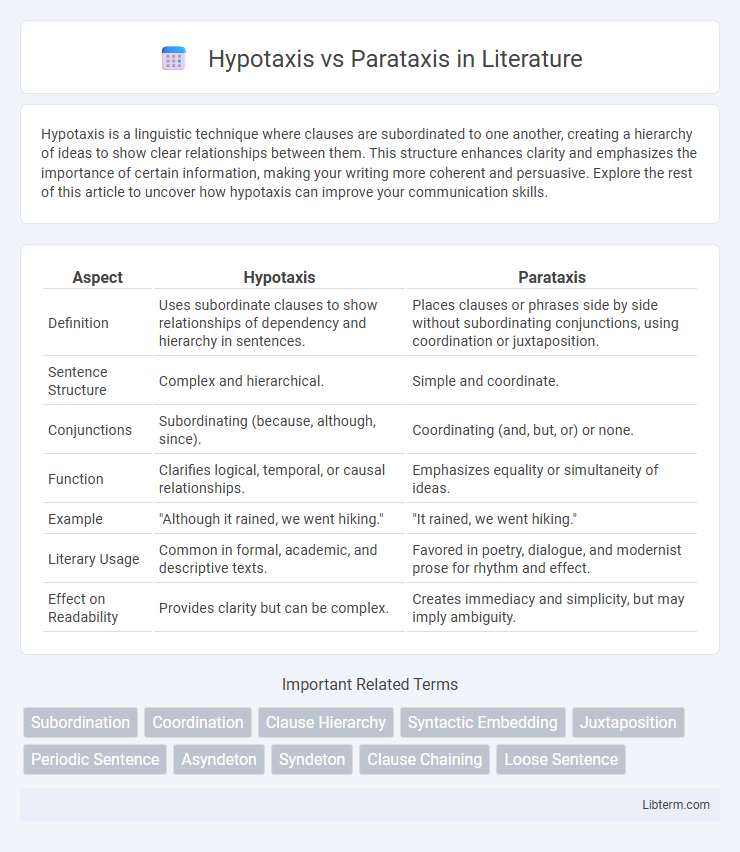Hypotaxis is a linguistic technique where clauses are subordinated to one another, creating a hierarchy of ideas to show clear relationships between them. This structure enhances clarity and emphasizes the importance of certain information, making your writing more coherent and persuasive. Explore the rest of this article to uncover how hypotaxis can improve your communication skills.
Table of Comparison
| Aspect | Hypotaxis | Parataxis |
|---|---|---|
| Definition | Uses subordinate clauses to show relationships of dependency and hierarchy in sentences. | Places clauses or phrases side by side without subordinating conjunctions, using coordination or juxtaposition. |
| Sentence Structure | Complex and hierarchical. | Simple and coordinate. |
| Conjunctions | Subordinating (because, although, since). | Coordinating (and, but, or) or none. |
| Function | Clarifies logical, temporal, or causal relationships. | Emphasizes equality or simultaneity of ideas. |
| Example | "Although it rained, we went hiking." | "It rained, we went hiking." |
| Literary Usage | Common in formal, academic, and descriptive texts. | Favored in poetry, dialogue, and modernist prose for rhythm and effect. |
| Effect on Readability | Provides clarity but can be complex. | Creates immediacy and simplicity, but may imply ambiguity. |
Introduction to Hypotaxis and Parataxis
Hypotaxis and parataxis represent two distinct syntactic structures used to organize ideas in language. Hypotaxis involves the use of subordinating conjunctions to create a hierarchy of clauses, indicating relationships like cause, time, or condition. Parataxis places clauses or phrases side by side without explicit connectors, allowing ideas to stand independently and often giving a more straightforward, additive effect.
Defining Hypotaxis: Structure and Purpose
Hypotaxis is a syntactic structure characterized by the use of subordinate clauses to show the relationship of dependence between ideas, ensuring clarity and complexity within sentences. This hierarchical arrangement allows for precise expression of cause, time, or condition, often marked by conjunctions such as "because," "although," or "if." In contrast to parataxis, which places clauses side by side without explicit subordination, hypotaxis organizes information to emphasize logical connections and detailed explanation.
Understanding Parataxis: Simplicity in Syntax
Parataxis employs simple, independent clauses arranged side by side without subordinating conjunctions, creating a straightforward and impactful sentence structure. This technique enhances clarity and immediacy by presenting ideas in a balanced, often rhythmic flow, facilitating easy comprehension. Writers use parataxis to convey directness and simplicity, making the text accessible and dynamically engaging for readers.
Key Differences Between Hypotaxis and Parataxis
Hypotaxis involves the use of subordinating conjunctions to create complex sentences where clauses depend on each other, emphasizing hierarchical relationships. Parataxis employs coordination or simply places clauses side by side without subordination, creating a more equal and straightforward connection between ideas. Key differences include the reliance on syntactic hierarchy in hypotaxis versus the flat, equally weighted structure in parataxis, impacting clarity and style in written and spoken communication.
Historical Origins and Evolution
Hypotaxis and parataxis are linguistic structures with roots tracing back to ancient Greek rhetoric, where hypotaxis denotes the use of subordinate clauses to show logical relationships, and parataxis involves placing clauses side by side without clear subordination. The evolution of these concepts can be observed in classical Latin literature, where hypotaxis became prominent in complex sentence constructions, while parataxis remained common in early oral traditions and poetic forms. Over time, syntactic analysis in modern linguistics has refined these terms, highlighting their role in sentence complexity, discourse coherence, and stylistic variation across languages.
Hypotaxis in Literature and Rhetoric
Hypotaxis in literature and rhetoric involves the use of subordinate clauses to create complex and nuanced sentence structures, enhancing the depth and clarity of expression. This syntactical technique allows for the precise articulation of relationships between ideas, contributing to a more persuasive and sophisticated argumentation style. Writers employ hypotaxis to build intricate narratives and emphasize logical connections, enriching the reader's understanding and engagement.
Parataxis in Modern and Classical Writing
Parataxis, characterized by placing clauses or phrases side by side without coordinating or subordinating conjunctions, plays a crucial role in both modern and classical writing, offering a rhythmic, straightforward style that emphasizes simplicity and immediacy. In classical literature, paratactic structures often convey authority and clarity, evident in texts such as Homer's epics where short, coordinated phrases enhance oral storytelling. Modern writers like Ernest Hemingway utilize parataxis to create terse, impactful prose that mirrors rapid thought and action, distinguishing their style from the more complex, subordination-heavy hypotactic sentences.
Linguistic Impact on Meaning and Style
Hypotaxis employs subordinate clauses to create complex sentence structures, enhancing clarity and precise logical relationships, which deepens the meaning and provides a more formal style. Parataxis uses simple, coordinate clauses placed side by side, producing a rhythmic, straightforward flow that conveys immediacy and informal tone. The choice between hypotaxis and parataxis significantly shapes the syntactic complexity, affecting how information is processed and the overall narrative style in linguistic expression.
Practical Examples and Analysis
Hypotaxis involves using subordinate clauses to show the relationship between ideas, such as in "Although it was raining, we went outside," where the clause "Although it was raining" depends on the main clause, adding depth and clarity. Parataxis places ideas side by side with equal importance, as in "It was raining; we went outside," creating a straightforward, sometimes abrupt style. Analyzing these examples highlights how hypotaxis enhances complexity and nuance, while parataxis emphasizes simplicity and immediacy in sentence construction.
Choosing Between Hypotaxis and Parataxis
Choosing between hypotaxis and parataxis depends on the desired clarity and complexity of sentences; hypotaxis uses subordinate clauses to show clear relationships and hierarchy, enhancing detailed explanation and logical flow. Parataxis places clauses or phrases side by side without subordinators, producing concise, direct statements ideal for emphasizing equality or immediacy between ideas. Writers prioritize hypotaxis for nuanced arguments and parataxis for straightforward, impactful expression.
Hypotaxis Infographic

 libterm.com
libterm.com